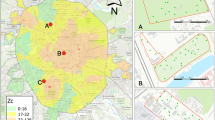Abstract.
Intensive urbanisation of the Croatian capital of Zagreb has led to a situation where very good agricultural soils, developed mostly on Pleistocene eolian sediments and alluvial and proluvian Holocene sediments are entrapped within urban and suburban areas. Therefore the influence of urban and industrialised environments on the accumulation of metals in agricultural topsoils has been investigated. On an area of 860 km2 of the wider Zagreb region, 331 samples were taken according to a regular 1×1 km square mesh. Samples were dissolved in aqua regia and analysed for Cd, Cu, Fe, Mn, Ni, Pb and Zn with flame atomic aqua regia absorption spectroscopy. The following concentration ranges have been determined: Cd 0.25–3.85 mg kg–1 (average 0.66 mg kg–1), Cu 4.30–183 mg kg–1 (average 20.8 mg kg–1), Fe 5.8–51.8 g kg–1 (average 27 g kg–1), Mn 79.2–1282 mg kg–1 (average 613 mg kg–1), Ni 0.70–282 mg kg–1 (average 49.5 mg kg–1), Pb 1.50–139 mg kg–1 (average 25.9 mg kg–1), and Zn 15.2–277 mg kg–1 (average 77.9 mg kg–1). Visualisation of the spatial data is made by the aid of GIS, and selected maps of the heavy metal concentrations in topsoils are displayed. Statistical multivariate analysis was carried out for quantitative study and data were processed by means of R-mode factor analysis, applying the varimax-raw rotational technique. F1, which grouped Cd, Pb, Cu, Zn and partially Ni, is characterized as a factor with strongly scattered anthropogenic influence. The elements in F2, Fe, Mn and partially Ni are mainly of geogenic, i.e. pedogenic, origin. The variations in concentrations of the investigated elements are thus of both natural and anthropogenic origins. The variations in the main soil constituents, particularly Fe and Mn, are determined primarily by the composition of different regolithic substrates of the fluvial origin in recent pedogenesis. High concentrations of nickel are also related to morphogenetic characteristics of the wider region, primarily basic and ultrabasic magmatic rocks of the surrounding mountain range. It is, however, assumed that the anomalous nickel concentrations in the vicinity of the highway and the airport are of anthropogenic origin, i.e. caused by fuel combustion. Copper is characterized by strongly scattered anthropogenic influence, which is related particularly to uncontrolled solid waste disposals or discharges of liquid waste from households or agricultural enterprises. With Zn, Pb and Cd, there are two possible ways of diffuse pollution. The Sava River, which drains the area and feeds the abundant Quaternary aquifer spreading below the major part of the investigated agricultural areas, has been exposed to intensive pollution by mining, industry and cities in the recent history. The part of the area with the highest determined concentrations of Zn, Pb and Cd was repeatedly flooded as recently as the previous decade; therefore, the recent sedimentation of the river deposits exposed to pollution is a very probable cause of the accumulation of metals in this until recently inundation area. The other way is atmospheric deposition of particles from urban sources (industrial emission, traffic, waste disposals, heating plants, etc.). In addition to agricultural enterprises, several economically important, but ecologically risky, facilities are situated in the vicinity of the water-protection area. The area is intersected by a very busy ring road, while a marshalling yard, the city dump, pharmaceutical and chemical industry, the district-heating plant and the airport are all located in close proximity. The geochemical maps show a clear relationship between human activities and metal concentration gradients.
Similar content being viewed by others
Author information
Authors and Affiliations
Additional information
Electronic Publication
Rights and permissions
About this article
Cite this article
Romic, M., Romic, D. Heavy metals distribution in agricultural topsoils in urban area. Env Geol 43, 795–805 (2003). https://doi.org/10.1007/s00254-002-0694-9
Received:
Accepted:
Issue Date:
DOI: https://doi.org/10.1007/s00254-002-0694-9




